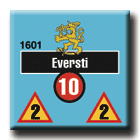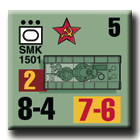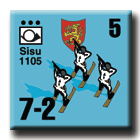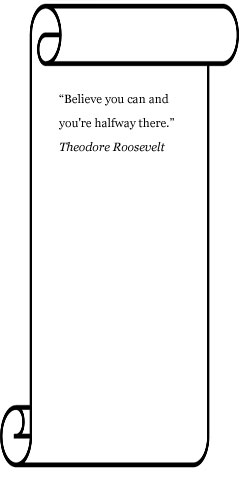| Back
to Finland
By Mike Bennighof, Ph.D.
October 2013
There are worse ways to make a living than
selling fun. You're pretty regularly forced
to return to a younger mindset, to embrace
play. Sometimes the years peel back in a more
literal fashion.
During the 1970s, I subscribed to the Avalon
Hill house magazine, known as The General.
Flipping through old copies, I now find most
of it drier than the dust that shakes out
of the old boxes holding them, but the magazine
was one of the few links connecting wargamers
in the days before the Internet. It contained
game analysis, news of upcoming games, and
most of all, variants for published games.
One of these was titled "Panzerblitz
1941," and it sparked something that
determined the course of my life for the decades that have followed. Just why that
might be, I'm not really sure. Looking at
it now, the writing is pretty bad and the
history worse, with the game design bringing
up the rear.
I became determined to write something just
like it.
At the time I didn't even own the game on
which it was based, Panzerblitz, the
now-ancient board game of armored combat on
the Eastern Front. I bought Kevin Davidson's
copy for $3, which he had gotten from his
grandmother for Christmas but didn't like
because it had complicated rules about sighting
and stuff like that. I read them and began
drawing Finnish counters for it. I was 14
years old and in the grip of madness.
I wrote about Panzerblitz ruining
my life for Green Ronin's Hobby Games:
The 100 Best, so I'll just let that stand
as my comment on the clunky old game that
inspired Panzer Grenadier and proof
that I'll do just about anything for a hot
chick who buys me alcohol. That Finnish variant
for Panzerblitz was pretty bad, too
— but was the first piece of writing
for which I ever drew a check.
Panzer Grenadier was always intended
to include a Finnish supplement, and Arctic
Front is its third iteration.
The First One is always special. Here's
a look at some of the scenarios.
 Finnish
Riviera Finnish
Riviera
30 November 1939
As Soviet troops marched across the border,
they expected to meet little resistance. Border
guards and troops of several independent jäger
battalions set up roadblocks and a few isolated
ambushes, but did not stand and fight. This
changed when the Soviets approached the first
sizable town, the seaside resort of Terijoki.
Finnish jägers attached to the elite
Cavalry Brigade ignored Marshal Carl Gustav
Mannerheim's orders to continue their retreat.
They dug in at Terijoki and awaited the Red
Army.
Note: This scenario uses maps from
Battle of the Bulge, a map and pieces
from Road to Berlin, and pieces from
Eastern Front. Only use Soviet leader
pieces from Eastern Front.
Conclusion
The Finnish light infantrymen fought with
berserk fury, contesting every building along
the string of resort towns. Superior Soviet
numbers forced them back, but the Finns fought
to the last man in several locations. The
sacrifice of these badly-needed professional
soldiers held up the Soviet advance for less
than 24 hours, and the Finnish Democratic
Republic was declared in Terijoki the next
day.
Design Note: Patrik Pössi provided some crucial additional
research for Arctic Front, and this scenario is a major beneficiary. Western accounts of this action claim it was fought by Finnish mounted cavalrymen, which is simply not true. The Sausage War
11 December, 1939
Under cover of darkness, several companies
of Soviet ski troops slipped through the Finnish
lines and attacked rear-area elements of Group
Talvela, hoping to cut the supply road north
of Tolvajärvi. The local commander, Lt.
Col. Pajari, organized a counterattack while
the Soviets were busy raiding a Finnish field
kitchen brimming with sausage soup. Fighting
grew so severe that one officer reported hearing
the ancient Finnish battle cry “Hakkaa
Päälle – Cut Them Down!”
Note: This scenario uses a board from
Battle of the Bulge and pieces from Eastern
Front.
Conclusion
Though the “Sausage War” is mentioned
in most popular accounts of the Winter War,
these tales seldom make much sense. Equipped
with skis, the Soviets (apparently “Red
Finnish” scouts) had the discipline
and skill to penetrate dozens of kilometers
behind the Finnish lines undetected, yet suddenly
lost all compsure when confronted by soup. What
is clear is that the Finnish Communists died
to the last man (though how many of them died
fighting is not).
Design Note: I've some experience
reporting/investigating war crimes and this
incident definitely raises my suspicions.
The Finns often get a pass as "the clean
Axis army," but war is a dirty business
and even Finland has the Karelian concentration
camps for which to atone.
Syväri Power
Plant
16 September 1941
The Svir River marked an important political
boundary for the Finnish government, which
did not want to press its attack any deeper
into the Soviet Union. Finnish military leaders
recognized that the shallow river did not
present much of a defensive line and planned
to hew closely but not exactly to their political
directives, crossing and digging in wherever
they felt it necessary. One such spot was
at the Syväri hydroelectric plant, an
important economic objective as well.
Note: This scenario uses boards from
Battle of the Bulge and Road to
Berlin, and pieces from Eastern Front.
Conclusion
The newly-arrived Soviet rifle division fought
surprisingly well against the Finns' best
unit, but ultimately proved no match for the
experienced light infantrymen. The Finns captured
the power station in savage close-quarters
fighting, overwhelming the Soviets' tank support
with close assaults. Lagus' forest blitzkrieg
would continue.
Design Note: Patrik once again came through, and made sure that there was
no lack of resources. This scenario was one I'd
really wanted to include as it has both Finnish
tanks and elite light infantry, against a
Soviet force with lower morale but the new
T-34.
Iron Ducklings
21 September 1941
Two intact T-34 tanks fell into Finnish
hands in and around the power plant, and Col.
Ruben Lagus ordered them immediately manned
and put at the spearhead of a renewed Finnish
advance to clear the Svir. The Finns named
their new vehicles "Sotka," the
Finnish name for a duck who lays her eggs
in other birds' nests and whose iron offspring
are very prominent in the Kalevala. Lagus
hoped the tough NKVD border troops holding
the railroad bridge at Latva over the Svir
would likewise mistake the T-34's for their
own tanks. An NKVD armored train had defied
all Finnish attacks, but surely it could not
resist the Red Army's own secret weapon. Note: This scenario uses boards from
Battle of the Bulge, pieces from Sinister
Forces, and boards and two KOM pieces
from Eastern Front.
Conclusion
Just as Lagus had hoped, the NKVD troopers
mistook the Sotkas for their own T-34's and
withheld their fire until they were on top
of the Soviet positions. The Finns drove the
Soviets out of the village and took the bridge,
but could not knock out the armored train.
With the help of their train the NKVD men
broke through the 7th Division's cordon and
raced northward to join the forces assembling
to defend Petrozavodsk, the capital of Soviet
Karelia. Even so, the Murmansk Railway had
been broken, a signal achievement for Finnish
arms.
Design Note: I have a Ph.D. It makes
me pretentious This
scenario is one of my favorites
for several reasons: Its title makes a literary
reference to the Kalevala, the Finnish national
myth. It includes captured armor, and the
fans always like that, particularly when they
come with special gonzo rules for their use.
There's an armored train, and elite Finnish
light infantry.
 Across
the Lake Across
the Lake
14 – 15 December, 1939
North of Suomussalmi, a lone Finnish bicycle
battalion (having traded its machines for
skis) held back two battalions of the Soviet
163rd Rifle Division. As both sides settled
into static positions, several days of waiting
in the bitter cold took an increasing toll
on the Soviet troops. Finally, Red Army regimental
commander Sharov decided to break the stalemate
with a daring night attack.
Note: This scenario uses a board
from Battle of the Bulge and a board
and pieces from Eastern Front.
Conclusion
The Soviets failed to surprise the Finns,
who mowed down the attacking Red Army infantry
in waves. With no cover on the ice, even darkness
could not save the 662nd from appalling losses.
Soon the division would be fighting for its
life, the survivors envying those evacuated
earlier with frozen feet.
Design Note: When we first published
Arctic Front, we had two small games
on battles of the Winter War still in print,
Blood on the Snow and Winter Fury.
To promote some cross-marketing we included
several scenarios from each of the battles
covered, Suomussalmi and Tolvajärvi.
Stalin's Giants
17 December 1939
The Red Army saw the invasion of Finland as
an experimental laboratory for new tactics
and weapons, and in mid-December rushed several
prototype tanks to the front for battlefield
testing. New heavy tanks had been developed
to break through enemy fortified positions,
and the Finnish concrete-and-steel bunkers
around Summa were exactly what the Red Army
had in mind when it asked for the big tanks.
The Finns knew the Soviets had gigantic tanks,
but all the same did not expect the monsters
that came looming out of the mist.
Note: This scenario uses boards from
Road to Berlin and a board and pieces
from Eastern Front.
Conclusion
The big tanks made three tries to get past
the Finnish positions, but their accompanying
infantry could not keep up and their commanders
would not risk them where anti-tank squads
could approach in stealth. Finnish anti-tank
rounds bounced harmlessly off the tanks' thick
skins, but a lucky shot snapped off the main
gun barrel of one KV and the remaining tanks
shepherded their wounded comrade back to the
start line. They would try again for two more
days, until one of the experimental SMK tanks
hit a mine and had to be abandoned inside
the Finnish lines. It was recovered in March,
but the Red Army had made its choice and the
KV became its new standard heavy tank.
Design Note: This is a fun scenario on its own merits, a straightforward armored assault
on a fortified position. What makes it ultra-cool is the presence of the Soviet SMK piece, and extra-strange vehicle with two turrets in a super-firing arrangement like a land battleship.
 Christmas
Morning Christmas
Morning
25 December, 1939
Despite massive casualties, the Soviets continued
their assault on the Mannerheim Line. Near
Lake Ladoga, on the eastern end of the line,
the Soviets realized the Finns had built fewer
fortifications and manned them more lightly
than elsewhere. The Finns depended on the
broad Suvanto River to make up for these deficiencies.
If the Soviets could surprise the Finns, they
could get across the river and break the Finnish
defenses.
Note: This scenario uses boards from
Battle of the Bulge and Road to
Berlin and pieces from Eastern Front.
Conclusion
Using the falling snow as cover, the Soviets
managed to get across the ice and into Finnish
positions. After severe hand-to-hand fighting
they took many of them and drove the Finns
back. Division command sent-in the only available
reserves, a collection of border guards and
volunteers, who helped drive the Soviets back
over the river.
Design Note: Thie best Panzer Grenadier scenarios have an ebb-and-flow of attack and defense, with reinforcements arriving to allow counter-attacks. That dynamic makes this a very fine and fun scenario to play. Guards Assault
15 July 1944
The Soviets opened their offensive into East
Karelia on 20 June, with a large-scale assault
including an amphibious landing on the shores
of Lake Ladoga. Olonets fell on the 25th and
Petrozavodsk on the 29th. By 10 July the Red
Army spearheads had reached the Finnish fallback
position, the heavily-fortified "U Line."
After bringing up their forces, they stormed
forward in a fresh attack designed to crush
the Finnish 5th Division in its exposed positions.
Note: This scenario uses a board
from Eastern Front and boards and pieces
from Road to Berlin.
Conclusion
The Guards made a spirited assault, but the
Finns pushed them back and no Soviets made
it past the first line of resistance. Col.
Heikki Saure's 2nd Regiment could call in
enormous artillery support by Finnish standards,
and more than 20,000 rounds were fired against
the attackers. With 140 Finnish guns pouring
down well-directed fire, the Soviet attack
broke up and by the 18th the Finnish division
commander, Maj. Gen. Kuusta Tapola, reported
that the Red Army's 37th Guards Rifle Corps
had been shattered and would not be able to
attack again without serious replenishment.
Design Note: This was another of
Patrik's suggestions, and I like it a lot.
A massive force of Soviet Guards charge forward
at a fortified line backed by substantial
artillery. The Soviet has numbers, the Finn
has morale and artillery support. There's
not a lot of subtlety involved.
Landing at Tornio
1 October 1944
Finland and the Soviet Union signed an armistice
on 19 September, 1944, requiring that the
Finns eject their former German comrades-in-arms
from northern Finland. At first the Finns
and Germans staged a "phony war,"
with the Germans pulling back at a leisurely
pace and the Finns pretending to chase them.
But after the Soviets suggested that they
might need to assist in the effort, the Finnish
high command sent Gen. Hjalmar Siilasvuo to
take charge. He immediately staged an unauthorized
amphibious landing at Tornio on the Swedish
frontier, behind the German lines.
Note: This scenario uses boards from
Eastern Front and pieces from Road
to Berlin.
Conclusion
The Finns had gathered two passenger liners
and seven freighters for the operation, but
their lack of experience in amphibious landings
quickly told. The ships had not been assault-loaded
(the most important items placed on board
last) and the troops went ashore without their
heavy weapons. One artillery battery had come
along but the Finns could not get the guns
ashore. No warships accompanied the landing
fleet, so there was no gunnery support from
that quarter, either — and no means
for the troops to contact them even if they
had been present. Even so the Finns took both
the bridge and the town, while the Germans
retreated northward in some disarray.
Design Note: I really hate Nazis,
and though the Germans who fought at Tornio
were not SS I did want to make sure the Lappland
War between Finland and Germany received a
suitable selection of scenarios. The Finns have
numbers and morale and absolutely nothing
else — it's a pure infantry force.
The Ties That Bind
3 October 1944
The Germans had always intended to evacuate
Tornio, but once their high command learned
that the city boasted a large steel railway
bridge linking Finland and Sweden, new orders
arrived to take it back. While the idiocy
of such a directive bears the hallmarks of
Adolf Hitler himself, the idea appears to
have originated within the Army command. Reinforced
with some second-line infantry, a company
of overaged French-built tanks and a small
group of angry, armed Finnish prostitutes
who had been chased out of Tornio as collaborators,
the Germans struck back at the Finnish beachhead.
The Finns had been unable to unload their
heavy equipment, but at least now had naval
support.
Note: This scenario uses boards from
Battle of the Bulge and Eastern
Front, and pieces from Road to Berlin
and Edelweiss.
Conclusion
The Germans could not eject the Finns from
Tornio or take the bridge, but they did place
an 88mm anti-aircraft battery on a small hill
that dominated Tornio's nearby port. Its shells
could not reach the Finnish ships, but kept
them away from the wharves and further hampered
Finnish reinforcement efforts. The gunboat
Uusimaa eventually knocked out the battery.
At least one Finnish soldier was shot and
killed by a prostitute who attached herself
to the German attack. Fighting continued around
Tornio and Kemi until the 10th, when the Germans
finally withdrew. Design Note: This one was so odd
I couldn't leave it out. It takes place on
the same boards at Landing at Tornio, and
the Finns have more troops but still lack
heavy weapons though they have a little off-board
artillery (thanks to the gunboats). The Germans
get ancient tanks of the 211th Panzer Battalion;
Gov. Spitzer's friends don't rate their own
counter though.
Don't be left out in the
cold — order Arctic
Front now!
|


